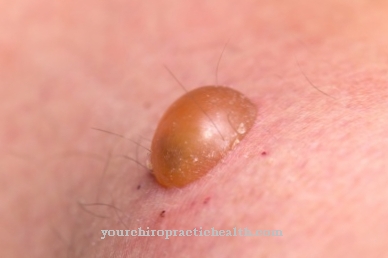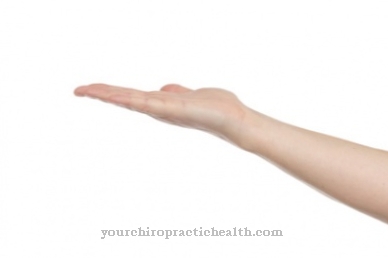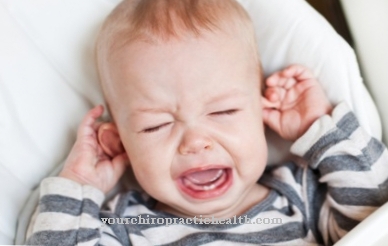Burn pain are a very unpleasant thing. A moment of inattention is often enough and the skin is burned. Once this has gotten to this point, there are numerous ways to reduce the burn pain, but also immediately after the burn, some things can be done to reduce the extent of the burn.
What is Burn Pain?

Burn pain occurs when the skin has come into contact with an object that is too hot or with a liquid. Stovetops, irons, saucepans, pasta water - they are among the most common causes of burns, which generally happen very often in the household. Immediately upon contact with the hot matter, a pain is felt that persists even when the heat source no longer touches the skin. This is the burn pain.
Reddening of the skin usually occurs very quickly in the affected area; later, depending on the severity of the burn, blisters can also form. These blisters are then filled with wound fluid. Cooling always provides good relief for burn pain. It can be done using cold water or ice packs and should be applied as soon as possible after contact.
causes
Burn pain occurs as a result of scalds or burns. These are skin damage caused by exposure to excessive heat on the skin. But chemical substances can also cause burn pain through burns, as can electrical injuries (electric shocks).
Since our skin has poor heat conductivity, it is sufficient that the heat source is only present for a very short time and a burn occurs. From an exposure of around 50 to 60 degrees Celsius, our skin suffers from burn damage and burn pain occurs.
The severity of the burn depends on the duration and strength of the heat. That is why there are very harmless burns up to and including those that can be life-threatening. To classify burns, there are different degrees of burns.
Diseases with this symptom
- combustion
Diagnosis & course
The diagnosis of burns and burn pain is very easy in most cases. This is because the person concerned can usually describe exactly what has happened, namely contact with a hot spring.
It is now important for the doctor to classify the degree of burns that the presented patient has. The depth of the combustion is crucial for this. Grade I burns only affect the top layers of the skin. In this case, only redness and burn pain appear, there is no blistering. Such a burn does not require any special treatment, it usually heals completely after a few days.
If there are second-degree burns, the dermis is also affected. However, this degree of burn is subdivided again depending on how far the dermis is affected. In both cases there is reddening, blistering and, of course, burn pain.
The worst case scenario is burns of the III. And IV. Degree. In the former, all skin layers are destroyed by the burn, the affected area may be charred. With the fourth degree of combustion one speaks as a rule of charring. This not only affects the skin, but also muscles, tendons and bones. In these cases, amputation can often no longer be avoided.
Complications
With burn pain, complications that greatly affect the patient's health are rare. In most cases, burn pain can be treated relatively well and does not lead to other health problems. A burn scar can be relatively painful and slow to regress.
It is not uncommon for scars after burns to stay on the skin forever and not go away completely. If severe burn pain occurs, it is essential to consult a doctor. This can assess the severity of the burn and treat the skin properly. In doing so, consequential damage and scars can be avoided.
Surgical interventions are usually not carried out, treatment is carried out with creams, ointments and painkillers. If the burn pain occurs after a very serious accident, amputations can also occur. Patients should never open burn blisters themselves. If the bladder needs to be opened, this should only be done by a doctor.
Otherwise germs and pathogens could cause inflammation and lead to more severe burn pain. The burn pain usually disappears after several days or weeks depending on the severity of the burn. After a burn, the skin must be treated immediately. The earlier the treatment takes place, the easier it is to avoid consequential damage.
When should you go to the doctor?
A doctor does not have to be consulted in every case in the case of burn pain. In most cases, the burns are minor and can be treated relatively well with means of self-help. There are no particular complications and the pain usually disappears after a few days. A visit to the doctor is necessary in the case of burn pain, if the pain is very severe and does not go away on its own.
In any case, a doctor must also be seen in the case of blisters and severe burns. This should usually be done from a second-degree burn. Burn blisters often occur, which should also be examined by a doctor. Under no circumstances should the patient open the burn blisters himself, as this can lead to inflammation and infections. If the lower layers of the skin are also affected by the burn pain, the hospital must be visited directly. Minor burns can also be treated relatively well with the help of drugs from the pharmacy.
Doctors & therapists in your area
Treatment & Therapy
The therapy for burn pain depends primarily on the degree of burn. Grade I burns are the easiest to treat. Cooling ointments and gels are used to relieve the pain of burns, and the affected area can also be treated with ice packs or cooling compresses.
If the burn pain was caused by scalds of the 2nd degree, the wound is usually not left open, but covered with gauze compresses and bandaged. Burn ointments may also be used here to relieve the pain of burns. In some cases it may be necessary to open the burn blisters. Absolute sterility must be ensured so that no pathogens can penetrate the wound and cause infections. In any case, the bandage must be changed regularly.
III burns and IV. degrees require an inpatient stay in any case, because the top priority is above all to avoid infections. In addition, these degrees of burns always require appropriate surgical measures. In any case, this includes the removal of the destroyed tissue. In some cases, very strong painkillers are administered against the burn pain, and in very bad cases the patient can be put into an artificial coma, as the burn pain would otherwise be unbearable.
In any case, these extreme cases should be treated in a special clinic in order to achieve the best chance of recovery.
Outlook & forecast
In most cases, people will experience only simple and minor burns. These do not require special medical treatment and will heal on their own. In some cases they can leave scars and wounds. The consequences of a burn always depend on the part of the body affected and the type of burn. If there is severe burn pain, a doctor must be consulted. He can classify the combustion according to its degree and initiate the appropriate measures.
Slight burns lead to reddened and irritated skin. In the case of severe burns, bars can also form in addition to the burn pain. In severe cases, bleeding also occurs and the skin layers are peeled off.
Medical treatment is not necessary in all cases. The burn pain can be relieved with the help of cooling creams. The affected areas on the skin can be covered with a plaster or a bandage to prevent inflammation from developing there. Usually the burns heal in a few days and the burn pain also goes away.
prevention
Home remedies ↵ for burns In order to prevent burn pain, it is important to avoid burns and scalds. Careful handling of hot objects or liquids is therefore essential.
Should a burn occur anyway, it is important to react immediately. The faster an initial treatment takes place, the better the chances of recovery and the lower the burn pain.
You can do that yourself
Various home remedies and measures promise relief for burn pain. The first thing to do is to cool the combustion. The affected area should be held under running cold water as soon as possible and then cooled with a damp cloth. The cooling should be stopped after fifteen minutes at the latest in order to avoid permanent tissue damage. Instead, the affected area can be treated with an ointment or a pain-relieving gel from the pharmacy and then covered aseptically.
In the event of a scald, cold air and the removal of soaked clothing will help. Burn pain in the mouth can be relieved by honey, quark or sucking ice cubes. Sauerkraut juice and onions soothe damaged skin and alleviate acute symptoms after a burn. For minor burns, antiseptic home remedies such as vinegar, echinacea and garlic are an alternative. In addition, homeopathic remedies such as arnica or Spanish fly can be used.
In the case of larger burns, the pain should always be treated under medical supervision. Until the emergency doctor arrives, rest and gentle cooling help against the pain. In the case of large-scale burns, no further self-measures are to be taken.

.jpg)






















.jpg)



